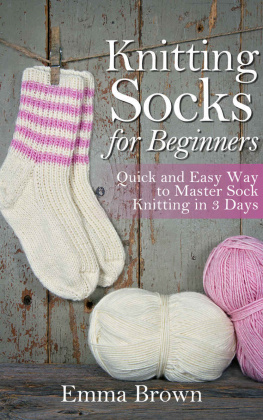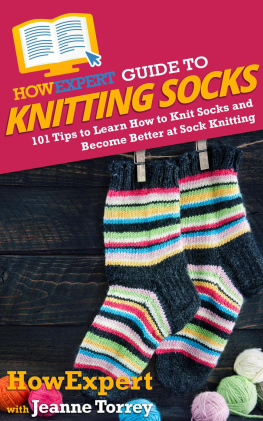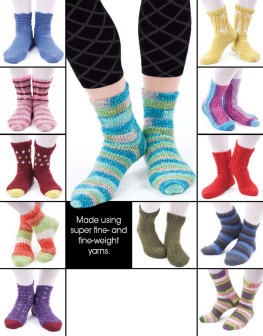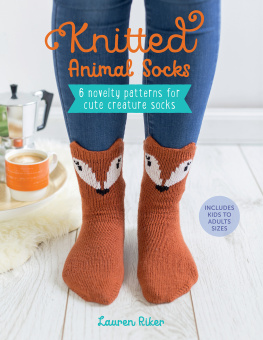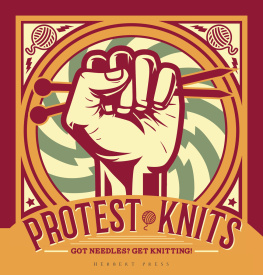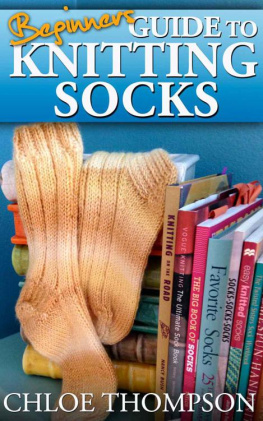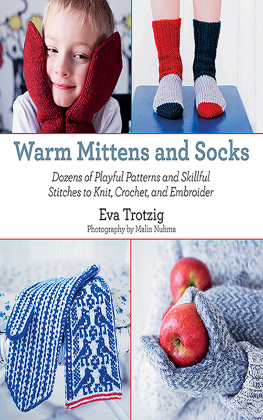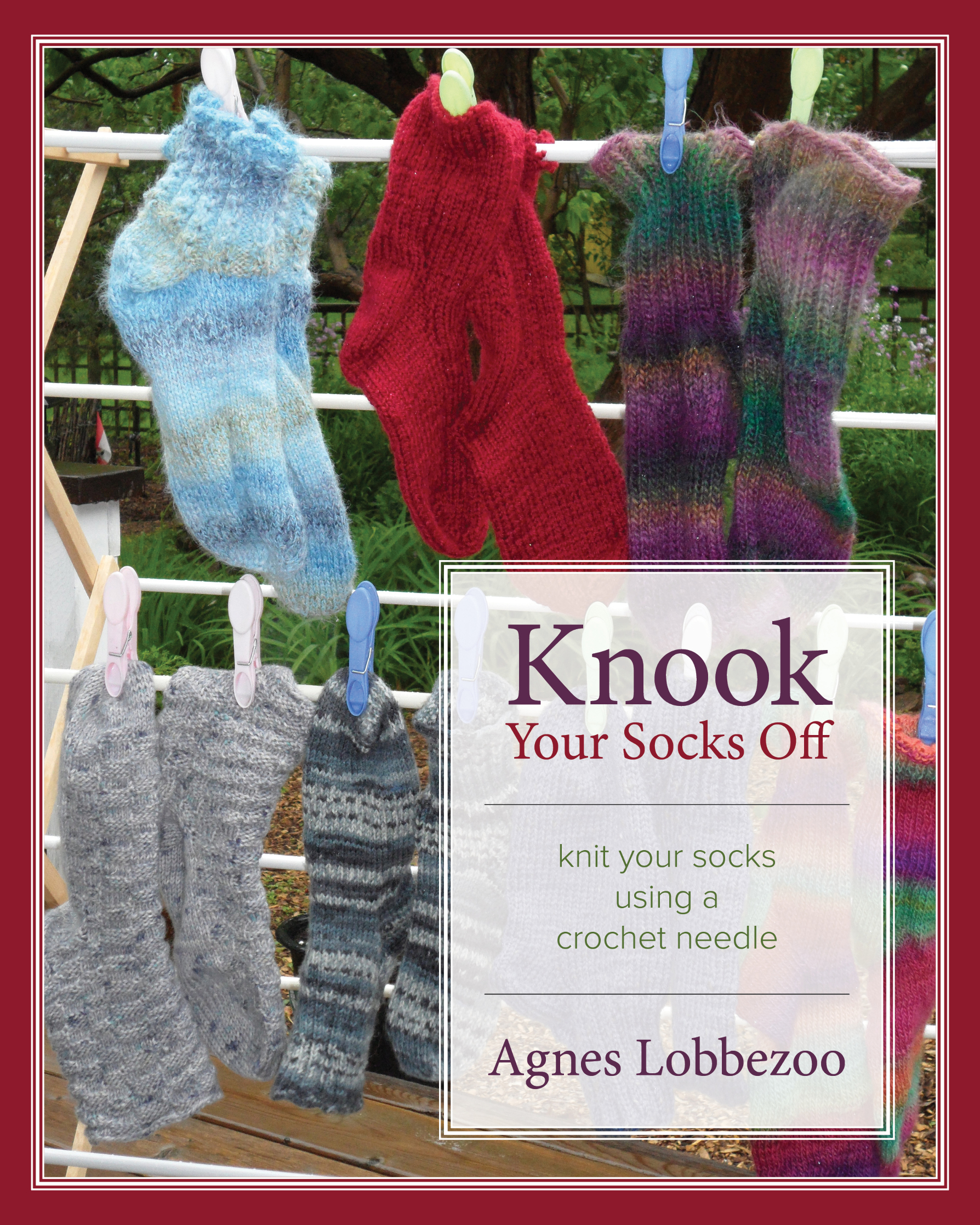Knook
Your Socks Off
knit your socks
using a
crochet needle
Agnes Lobbezoo
To knit a stocking needles four,
Cast on three needles and no more,
Each needle stitches eight and twenty,
Then one for seam stitch will be plenty.
Nineteenth-century rhyming knitting pattern
Contents
Acknowledgements
If a book gets judged by its cover, it is thanks to those who helped make it happen!
First off all, grateful thanks to my mom, Tineke Meijerman, who probably did not realize at the time that when she sent my siblings to bed one December night, letting me stay up in wonder and anticipation of what was to come, that I was singled out for something more after St. Nicolas visited and brought us presents. That evening I learned how to knit. It was the best present a five-year old could want.
Many thanks to my dearest husband Roelant, my wonderful children Adrian, Justen and Celina, mother in-law, Joke and Alexis Schenk, who are all probably wondering if I will ever do anything else, for all they see are more and more socks being made the knook way. Thank you for your patience.
And to my equally long-suffering friends, Heather Hockley, Luanne Evans, Margaret Weir, Donna Baines, Debbie Koens and Jacqueline Luinstra. Thank you, dear friends for watching me week after week with yet again a different ball of wool, creating yet another pair of socks. And to my dear friends, Anees Vakharia, for the title suggestion and Christine Vakharia, for proofreading my work and spending all that time unravelling my manuscript like a piece of knitting. Without her help, I would not be able to feel such satisfaction in fulfilling my dream of passing on this special technique of knooking beautiful socks to other passionate crafters.
Blessings to you all,
Agnes
Introduction
Imagine wearing socks that you can make without using four short needles where the stitches might slide off. No more fiddling, no more ladders in your socks that form when you change from one knitting needle to the next. Socks that look like you actually knit them, but instead you used a simple crochet hook! That is what knooking your socks will do for you.
When I first read about how to knook, the simplicity of the word described the better of two worlds: kn itting a product using a crochet h ook . If it sounds a bit daunting, but you have knitted scarves and crocheted doilies using basic stitches, this book is for you, whether your skill level is beginner, intermediate or advanced. Add a little bit of Tunisian crocheting in there, and you are ready to knook.
Even though I learned how to knit as a young five-year-old in the Netherlands, knitting socks was never one of those skills I really wanted to pursue. I had the experience but not the drive to continue knitting socks. So instead, I decided to crochet socks. Crocheting goes faster than knitting; the thrill of making a pair of socks in a day [using thick wool] is sheer pleasure. And crocheted socks get noticed, for they look different and are just as snazzy! However, it did not take me long to realize that depending on the stitch used to crochet socks, they may not always be the most comfy to wear, and they are costly to make, for crocheting takes more wool.
In 2009 I discovered how to knook. A light went on! It was so simple. I knew how to knit socks and how to crochet socks, so surely I could knook socks too!
I have not looked back. It is the way to go! You wear your socks and you meet a friend or acquaintance who notices them. You might get asked if you knit your own socks. When you answer, make sure you watch the reaction you get when you tell them that you actually crochet knitted socks using a new technique - knooking. For this is not going to make sense. Everyone knows what knit socks look like. Saying that you knooked them will surely be a surprise. I have seen this reaction over and over again. So I hope that you will catch the bug and start knooking your socks. It is relatively easy, fast if you use thicker wool and delicately sweet using thinner wool. It is like a treat you cant get enough of. Buying new sock wool will be something that you just have to do. And you can make a pair to match an outfit so easily!
This book will show you how to make your own pair, step-by-step with pictures. Once you know how to knit and purl, you can create your own style of socks with the stitches you want to use. In the end, my desire is that you will agree with me that making a pair of socks the knooked way, is the way to go!
You may find that knitting a pair of socks is much faster, especially if you have been knitting socks for a long time. I am hopeful that this method will become a new acquired way of making socks that is just as fun to do.
Tools you will need
This picture shows the tools of the trade. A starter knooking kit may include three bamboo hooks with a hole at the end, as shown in the one hook with the pink string attached, and three different coloured strings. The hooks are of different sizes, and your choice of wool determines the size of the hook to use. Also in the picture are a few metal crochet hooks. Those will need to be modified if you want to use them for knooking. If you feel comfortable using only the bamboo needles, that is fine too. Unfortunately, bamboo needles do not come in very small sizes. The nice thing about bamboo hooks in the knook package is the fact that they are tapered at the end, so the stitches slide off nice and easy.
If using a metal crochet hook, you will soon get used to manipulating the stitches over the end of the hook, and it should not be a big problem once you are on the go. The string provided with the bamboo knook is soft and smooth. You need the straight knitting needles to knit the heel, and I added the glasses just for fun.
About the wool to use
Wool for socks can be bought anywhere; big box stores and privately owned wool stores carry lots of wool. Since socks are a piece of clothing you want to wear for as long as you can, it is important that the wool you use is the right quality. In a way it is sad that so much of the acrylic wool available comes in the most beautiful variegated colours, yet is not good for socks. Unfortunately, neither is 100% cotton. This does not mean that you cant knook yourself a pair of socks using acrylic wool or cotton. Once you wear them though, they will start to sag pretty quickly and will definitely not wash well. The good news is that acrylic with a blend of wool will work out well for socks. And any wool blend with acrylic should be fine, such as Alpaca, Layne, Angora or other wool. Make sure you read the label when choosing your wool. The wool blend with acrylic will keep your socks in shape, wash easily, feel warm and the socks are nice to look at. Sock wool that is 100% wool is fine as well and comes in many different colours, styles and thickness, though, I find that these ones wear out faster. Generally socks made of wool are to be hand washed and air dried, but if you are brave enough and run a pair through the washing machine and put the machine on the right setting, they should come out just fine. Mine get washed with my wool sweaters. Make sure you do not put wool socks in the dryer, just as you would not do with wool sweaters either! So make it a practice to hang your wool socks out to dry. Using bamboo wool is a personal taste. It feels nice and soft on your hands as you use it, but it pills after a few washings. One thing to keep in mind when using wool is the thickness. Some of the most marvelous sock wool comes in variegated colours and make the nicest patterns for socks. A lot of wool comes in thin strands, making thin, lightweight socks. These will also take longer to make, for the stitches are finer and smaller. Thick wool will speed up the creation of a pair of socks. Generally a 100 gram ball of wool will make one pair of socks. If the wool is fine, you might even get two pairs out of it, depending on the cuff length of the sock you plan to make. Size is also something to consider. When making a pair of socks for your spouse, adult son or boyfriend, keep in mind that you will need more than a 100 gram ball of wool. Another interesting aspect is the look of a pair of finished socks. Just like when you crochet a pair of socks, the shape of the socks may seem odd at first. I have pictures later in the book that will show this. This does not mean that you did anything wrong. Interestingly enough, once you put them on, they fit just fine and look just as great! So do not let the look of your socks discourage you. Again, this is also more evident with thicker sock wool than lightweight wool.


